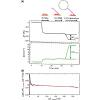当前位置:
X-MOL 学术
›
Phys. Rev. Appl.
›
论文详情
Our official English website, www.x-mol.net, welcomes your
feedback! (Note: you will need to create a separate account there.)
Hydrodynamics of Quartz-Crystal-Microbalance DNA Sensors Based on Liposome Amplifiers
Physical Review Applied ( IF 3.8 ) Pub Date : 2020-06-24 , DOI: 10.1103/physrevapplied.13.064059 Adolfo Vázquez-Quesada , Marc Meléndez Schofield , Achilleas Tsortos , Pablo Mateos-Gil , Dimitra Milioni , Electra Gizeli , Rafael Delgado-Buscalioni
Physical Review Applied ( IF 3.8 ) Pub Date : 2020-06-24 , DOI: 10.1103/physrevapplied.13.064059 Adolfo Vázquez-Quesada , Marc Meléndez Schofield , Achilleas Tsortos , Pablo Mateos-Gil , Dimitra Milioni , Electra Gizeli , Rafael Delgado-Buscalioni

|
The quartz-crystal microbalance (QCM) has become an important technique for the detection of biomolecules and their interactions. Acoustic sensing of DNA requires hybridizing the oligonucleotide chain with a nanoparticle that acts as an acoustic amplifier. In this device, the amplifier remains suspended in the liquid, nanometers away from the surface. The hydrodynamics of nonadsorbed nanoparticles in QCM sensing devices has, however, been overlooked in the literature. Here, we show that the acoustic response (shifts in frequency, , and dissipation, ) of the amplifier-target complex is determined by the hydrodynamic wall stress. Our study focuses on an alternative type of DNA sensor based on liposome-DNA complexes and provides a theoretical analysis backed up by experiments with 1-palmitoyl-2-oleoyl-sn-glycero-3-phosphocholine liposomes. The target DNA strands are attached on one side to surface-adsorbed neutravidin through a biotin linker, while the other side is anchored to a liposome acting as an amplifier. A range of liposome radii and double-stranded-DNA contour lengths are studied, covering sizes up to the wave penetration depth (). Simulations, based on the immersed boundary method and an elastic-network model, are in excellent agreement with the experiments. We derive an analytical expression for the acoustic impedance, which reflects strong signal amplification as the liposome gets closer to the wall. This enhancement is due to hydrodynamic reflection: the ambient flow induces a stress on the liposome surface, which propagates back to the resonator. For this reason, acoustic signals are extremely sensitive to the distribution of the liposome-wall distance (which we determine from the mechanical properties of double-stranded-DNA chains). Our approach helps in deciphering the role of hydrodynamics in acoustic sensing and reveals the role of parameters hitherto largely unexplored. A practical consequence may be improvements in the design of biosensors and detection schemes.
中文翻译:

基于脂质体放大器的石英-晶体-微天平DNA传感器的流体动力学
石英晶体微量天平(QCM)已成为检测生物分子及其相互作用的重要技术。DNA的声感测需要将寡核苷酸链与充当声放大器的纳米粒子杂交。在该设备中,放大器保持悬浮在液体中,距离表面纳米级。但是,QCM传感设备中未吸附的纳米颗粒的流体动力学却在文献中被忽略。在这里,我们证明了声学响应(频率变化,和耗散, 放大器-目标复合体的)由流体动力壁应力确定。我们的研究集中于基于脂质体-DNA复合物的另一种类型的DNA传感器,并提供了以1-棕榈酰基-2-油酰基-sn-甘油-3-磷酸胆碱脂质体为实验基础的理论分析。靶标DNA链的一侧通过生物素接头连接至表面吸附的中性亲和素,而另一侧则锚定至充当扩增子的脂质体。研究了一系列脂质体半径和双链DNA等高线长度,涵盖了直至波穿透深度()。基于沉浸边界方法和弹性网络模型的仿真与实验非常吻合。我们导出了声阻抗的解析表达式,当脂质体越来越靠近壁时,该表达式反映了强烈的信号放大。这种增强是由于流体动力反射引起的:环境流在脂质体表面上引起应力,该应力传播回谐振器。因此,声信号对脂质体-壁距的分布极为敏感(这是由双链DNA链的机械性能决定的)。我们的方法有助于破译流体力学在声学传感中的作用,并揭示了迄今尚未探索的参数的作用。实际的结果可能是生物传感器和检测方案设计的改进。
更新日期:2020-06-25
中文翻译:

基于脂质体放大器的石英-晶体-微天平DNA传感器的流体动力学
石英晶体微量天平(QCM)已成为检测生物分子及其相互作用的重要技术。DNA的声感测需要将寡核苷酸链与充当声放大器的纳米粒子杂交。在该设备中,放大器保持悬浮在液体中,距离表面纳米级。但是,QCM传感设备中未吸附的纳米颗粒的流体动力学却在文献中被忽略。在这里,我们证明了声学响应(频率变化,和耗散, 放大器-目标复合体的)由流体动力壁应力确定。我们的研究集中于基于脂质体-DNA复合物的另一种类型的DNA传感器,并提供了以1-棕榈酰基-2-油酰基-sn-甘油-3-磷酸胆碱脂质体为实验基础的理论分析。靶标DNA链的一侧通过生物素接头连接至表面吸附的中性亲和素,而另一侧则锚定至充当扩增子的脂质体。研究了一系列脂质体半径和双链DNA等高线长度,涵盖了直至波穿透深度()。基于沉浸边界方法和弹性网络模型的仿真与实验非常吻合。我们导出了声阻抗的解析表达式,当脂质体越来越靠近壁时,该表达式反映了强烈的信号放大。这种增强是由于流体动力反射引起的:环境流在脂质体表面上引起应力,该应力传播回谐振器。因此,声信号对脂质体-壁距的分布极为敏感(这是由双链DNA链的机械性能决定的)。我们的方法有助于破译流体力学在声学传感中的作用,并揭示了迄今尚未探索的参数的作用。实际的结果可能是生物传感器和检测方案设计的改进。










































 京公网安备 11010802027423号
京公网安备 11010802027423号